September Data - November Reporting
MICHIGAN UNEMPLOYMENT RATE EDGED UP IN SEPTEMBER

On a seasonally adjusted basis, Michigan’s unemployment rate edged up by two-tenths of a percentage point to 3.9 percent during September.
The U.S. unemployment rate remained unchanged at 3.8 percent during the month. Michigan’s jobless rate was 0.1 percentage points above the U.S. rate. Comparable to trends seen last month, Michigan’s unemployment rate was greater than most states. In September, Michigan’s jobless rate of 3.9 percent was the 11th highest rate in the nation. Across the U.S., jobless rates ranged from 1.6 percent in Maryland to 5.4 percent in Nevada.
Since September 2022, the national unemployment rate edged up by three-tenths of a percentage point, while the statewide unemployment rate was reduced by four-tenths of a percentage point. Over the year, Michigan’s unemployment rate decrease of 0.4 percentage points was tied with Alabama and South Carolina as the 19th largest drop observed nationally.
Over the month, Michigan’s labor force levels rose by 0.5 percent, while the U.S. workforce was little changed, inching up by 0.1 percent. Statewide employment levels increased by 0.3 percent during September, while national employment levels edged up by 0.1 percent. Total unemployment in Michigan increased by 4.9 percent over the month, while total unemployment in the U.S. rose minimally by 0.1 percent.

Source: Local Area Unemployment Statistics, Michigan Center for Data and Analytics, Michigan Department of Technology, Management & Budget
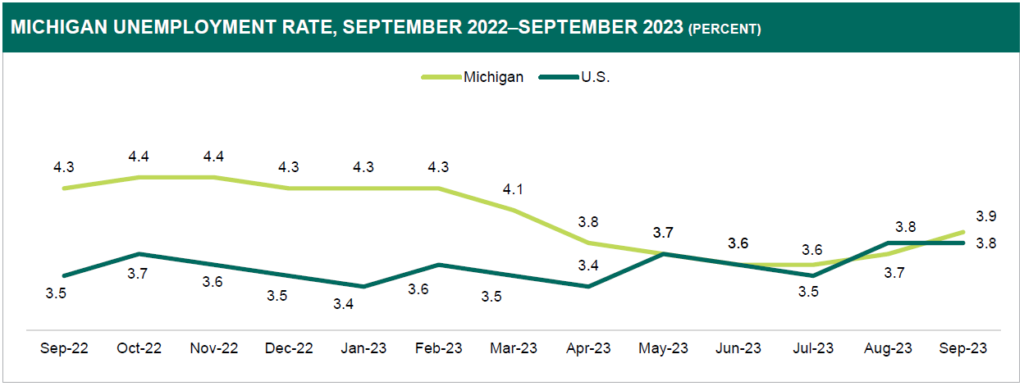
Source: Local Area Unemployment Statistics, Michigan Center for Data and Analytics, Michigan Department of Technology, Management & Budget
Over the year, Michigan’s labor force rose by 3.2 percent, 1.2 percentage points above the workforce gain seen nationally. Since September 2022, statewide employment levels rose by 3.7 percent, while nationwide employment levels increased by 1.7 percent. Total unemployment in Michigan receded by 8.6 percent over the year, while total unemployment in the U.S. rose by 10.2 percent.
REIMA NASSER
Economic Analyst
MICHIGAN NONFARM PAYROLL JOBS DECLINE FOR ONLY SECOND TIME THIS YEAR
Total nonfarm payroll jobs in Michigan fell during September, edging down by 10,000 or 0.2 percent over the month, to 4,432,800. This is the second month during 2023 that Michigan recorded a job decline at the seasonally adjusted total nonfarm level. Statewide employment remained 16,700 or 0.4 percent below its February 2020 pre-pandemic level. Additionally, Michigan was only one of six states that noted a seasonally adjusted total job decline during September.
On the nationwide level, total nonfarm payroll jobs rose marginally in September, increasing by 0.2 percent over the month. This employment uptick added to the streak of consecutive monthly job additions since December 2020.
Only four of the 11 statewide supersectors recorded seasonally adjusted job additions this month. On a percentage basis, jobs within the Information (+0.7 percent) and Trade, transportation, and utilities (+0.3 percent) recorded the largest gain during September. Noteworthy employment declines occurred within several major industries including the Leisure and hospitality (-2.0 percent) and Manufacturing, Private education and health services, and Other services (-0.4 percent) sectors.
Nationally, seasonally adjusted job gains were recorded in every major industry sector besides Information, which declined by 5,000 or 0.2 percent in September.
Yearly Employment Growth Observed in Majority of Michigan Industry Sectors
Seven of Michigan’s 11 major industry sectors recorded seasonally adjusted job growth over the year. Consequently, total nonfarm payroll jobs moved up by only 51,400 or 1.2 percent since September 2022. This rate increase was tied with Wisconsin and Virginia for the seventh smallest yearly increase among all states. Notable additions were found within several major sectors including Government (+24,000) and Private education and health services (+16,400). Other noteworthy increases were recorded within industries such as the Construction (+7,200) and Trade, transportation, and utilities (+6,400) sectors.
On the nationwide level, seasonally adjusted total nonfarm payroll jobs advanced by 2.1 percent, 0.9 percentage points higher than Michigan, as of September 2022. Nationally, the Information (-77,000) sector was the only major industry sector that displayed job declines during this time frame. Numerically, the largest over-the-year job additions occurred within the Private education and health services (+1,011,000), Leisure and hospitality (+687,000), and Government (+625,000) major industry sectors.
Most Michigan Metro Areas Record Job Gains During September
Eleven of Michigan’s 14 Metropolitan Statistical Areas (MSAs) recorded job additions in September, on a not seasonally adjusted basis. Three regions, Muskegon, Flint, and the Detroit MSA all noted job growth below the statewide average (-0.1 percent). Nine of the 11 metro areas that recorded a positive job gain this month had a rate higher than the national average (+0.4 percent).
Over the month, jobs within most regional Mining, logging, and construction; Trade, transportation, and utilities; Leisure and hospitality; and Other services recorded typical seasonal job declines.
Conversely, employment within Professional and business services and Government industry sectors in most areas recorded typical seasonal job gains.
Since September 2022, total nonfarm employment across 13 of Michigan’s 14 metro areas noted not seasonally adjusted job growth, led by Ann Arbor (+4.3 percent), Lansing (+2.5 percent), and Midland (+2.4 percent). Battle Creek saw no change in employment over the year.
JIM BIRNEY
Economic Analyst
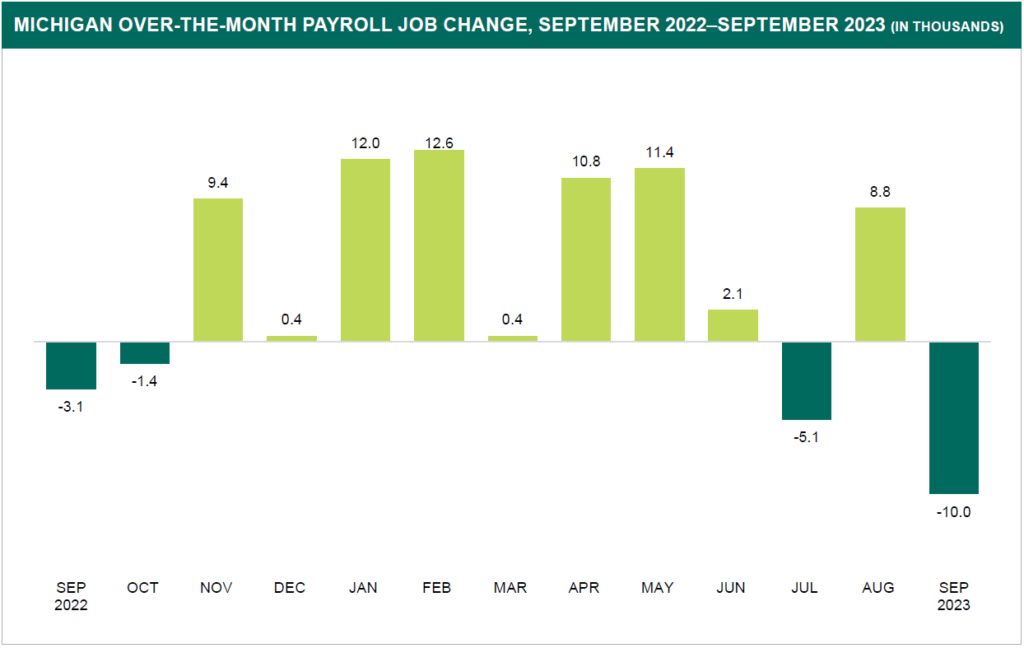
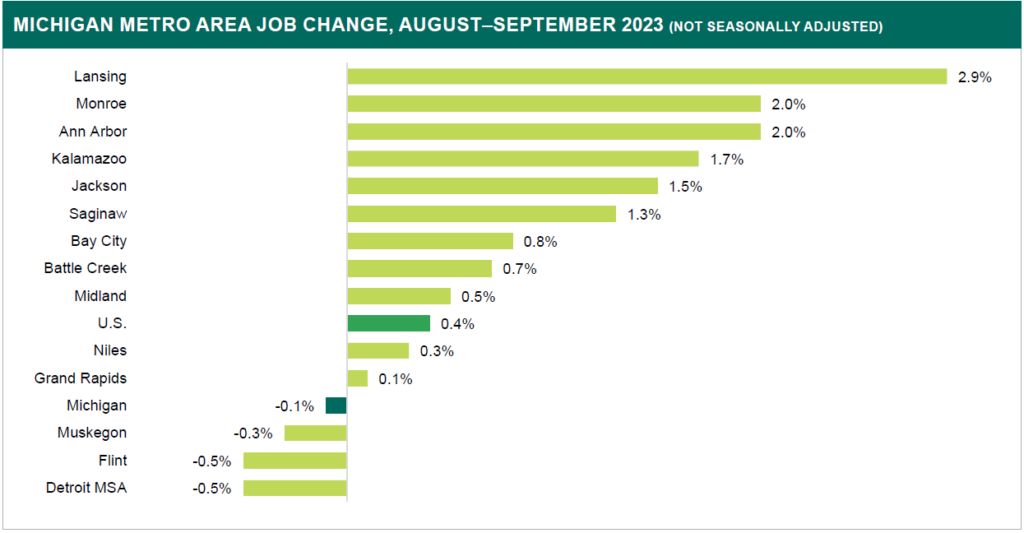
Source: Current Employment Statistics, Michigan Center for Data and Analytics, Michigan Department of Technology, Management & Budget
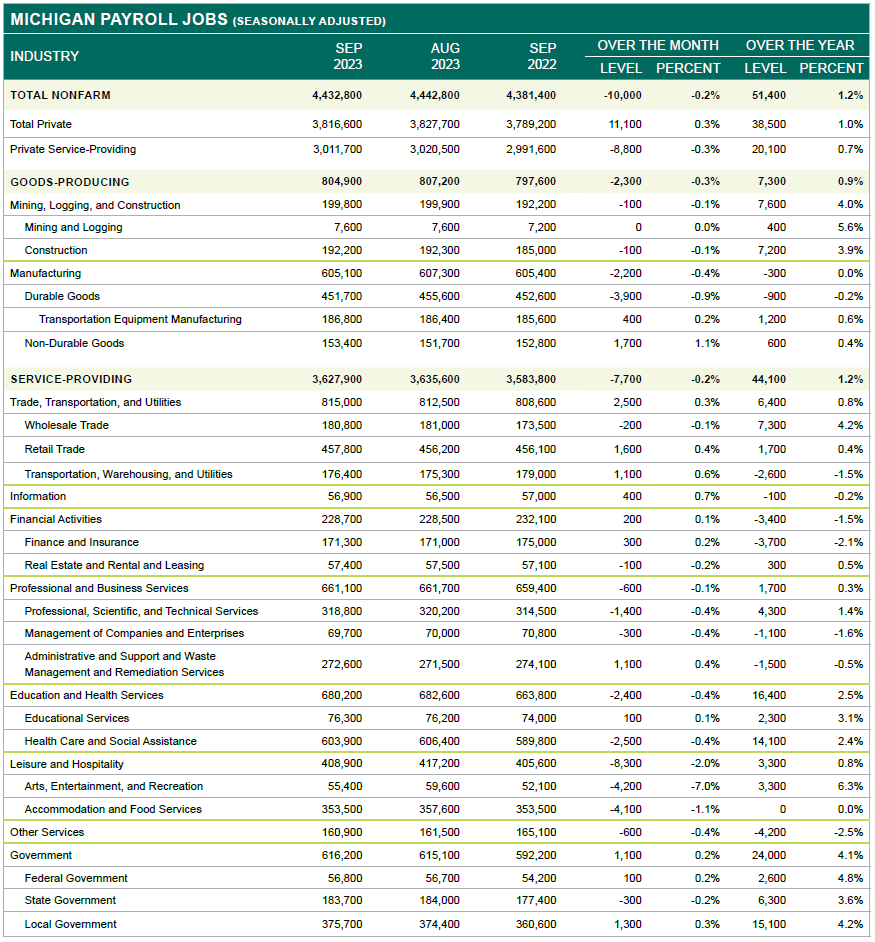
Source: Current Employment Statistics, Michigan Center for Data and Analytics, Michigan Department of Technology, Management & Budget
HIRES RATE DROPS TO NEAR FOUR-YEAR LOW
Michigan’s job openings rate (5.1 percent) saw a half percentage point jump in the latest release of the state Job Openings and Labor Turnover Survey (JOLTS). The separations rate also increased over the month (3.6 percent). Conversely, the hires rate (3.4 percent) and labor turnover rate (7.0 percent) were down in August. Both the quits rate (2.1 percent) and layoffs/discharges rate (1.2 percent) remained the same.
Job Openings Grew
Job openings increased by approximately 23,000 openings from the month prior, moving from 216,000 in July to 239,000 in August. This was reflected in a 0.5 percentage point increase in Michigan’s job openings rate to 5.1 percent. Despite this jump, Michigan remained one of the states with the lowest rate of openings at 5th, which was (and still remained) below the national rate at the time (5.8 percent).
The unemployed persons to job openings ratio dropped from 0.82 to 0.77 in August. This meant that there were around 7 unemployed persons for every 10 job openings. Michigan had the 10th highest ratio of unemployed persons to job openings for the second month in a row and was above the national ratio for the same period (0.66).
Separations Increased Marginally
The separations rate experienced a small increase from July to August, moving 0.2 percentage points to 3.6 percent. Numerically, 6,000 more individuals separated from their jobs than in the previous month (158,000). Michigan’s separations rate was equal to the national rate at the time and had the 12th highest rate of all other states.
Both the quits rate and the layoffs/discharges rate were stagnant, measuring 2.1 percent and 1.2 percent, respectively. While Michigan’s quits rate was below the national average at the time (2.3 percent), layoffs/discharges was slightly above the national rate (1.1 percent).
Michigan Hires Rate Hits Near Four-Year Low
The hires rate for Michigan dropped by 0.3 percentage points to 3.4 percent in August. Michigan had the 9th lowest rate compared to all other states and was below the national rate (3.7 percent). Notably, this was the lowest the hires rate has been since January 2020 (3.3 percent). After peaking in the wake of mass COVID-19 layoffs and subsequent hires at 9.2 percent in June 2020, hires have been on a downward trend. Over the past year, the decline in hires has begun to slow down as Michigan’s rates begin to stabilize back to pre-2020 values.
KRYSTAL JONES
Economic Analyst
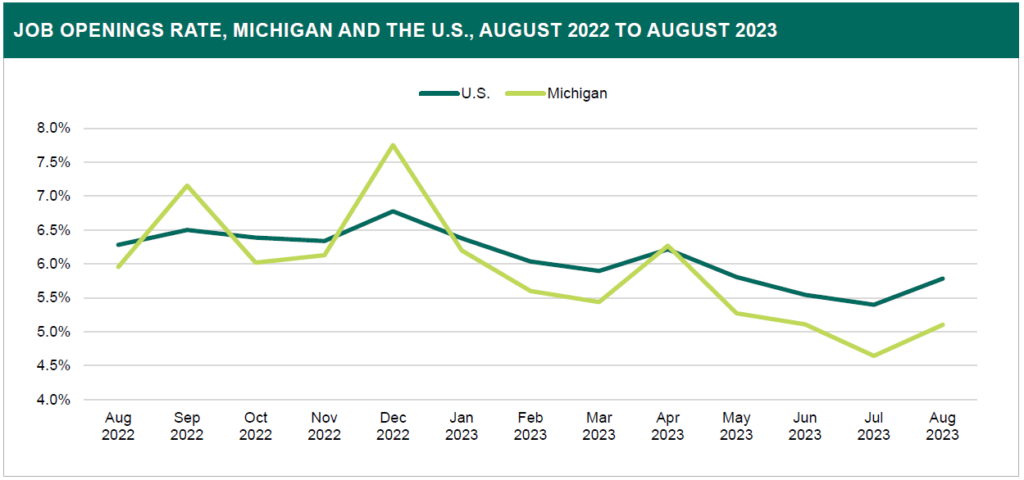
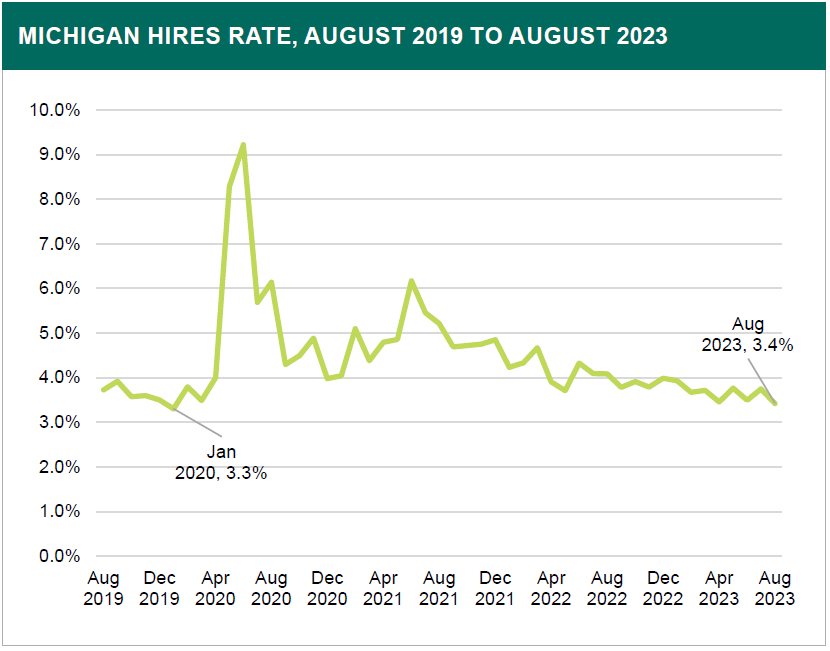
Source: Job Openings and Labor Turnover Survey, U.S. Bureau of Labor Statistics
Disclaimer
The Above Information was created and disseminated by the Department of Technology, Management, and Budget and the Bureau of Labor Market Information and Strategic Initiatives from the State of Michigan. Specialized Staffing does not hold any rights or ownership to this content. For more information, please contact your Michigan Bureau of Labor Representative.
